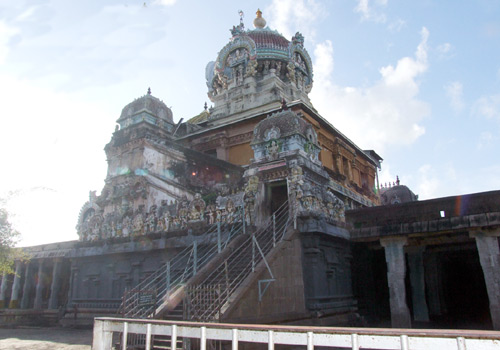Tirugnana Sambandar one of the Saivite Gurus was born to
Shivapada Hrudayar and Bagavati Ammai.
He is regarded as the incarnation of Lord Muruga. He is praised as Ilaya Pillayar-younger
son.
He came to Brahmma Theertham with
his father. The father left the boy on
the bank of the tank and went for a bath.
Hungry child began to cry for food.
Lord Shiva asked Mother Parvathi to feed the boy. Mother not only fed the little boy with milk
but with wisdom too blended in the milk.
Sambandar was happy and sat on the steps of the tank with the milk spots
on the face. Shivapad Hrudayar blamed
the boy for accepting the milk from somebody.
When the father was about to beat the boy, he showed upwards the divine
parents who fed him. Shivapada
Hrudayars joy knew no bounds to hear the truth. The little childs first hymn Thodudaya
Sevian was born her3e to enrich the spiritual literature of Tamil. Gana Sambandar had sung 67 pathigams of 10
verses each, Tirunavukkarasar 3 pathigams and Sundarar one pathigam on Lord of
Sirkali temple.
Festivals:
Brahmmotsavam
in the temple begins on the Chithirai Tiruvadhirai day in April-May.
The event of Mother Uma feeding Gnanasambandar is celebrated on the
second day. The milk fed to the child saint is offered as Prasad.
Consuming this milk ensures salvation to the devotee, it is believed. Oil abishek is offered to Lord Uma Maheswarar in the hill temple on the
first day of Tamil months Chithirai (April-May); Aadi (July-August);
Aipasi (October-November); Thai (January-February) and on Karthikai
Deepam in November-December, Margazhi Tiruvadirai in December-January
and Shivrathri in February-March. Special pujas are performed on Aadi
Pooram in July-August, Navrathri in September-October, Thai new moon day in January-February, Vaikasi Moola Star day in May-June, Aani Rohini
Star day in June-July and Sadayam Star day in Aipasi in
October-November.
Opening time:
The temple is open from 6.00 a.m. to 1.00 p.m. and from 4.00 p.m. to 9.00 p.m.
Sirkali
is considered to be the 14th of the Tevara Stalangal loacted to the
North of the river Kaveri in the Chola region of Tamilnadu.It is a center for Bhairava
worship, and the site of authorship of several works.
This is a vast temple complex with 3
different Shiva Shrines. The Bhramapureeswarar shrine is housed in the lower level. The
second level houses Periyanakar with Periyanayaki on a Thoni & hence the name
Thoniappar. Sattainathar/Vatukanathar is also housed here.
From the steps leading to the
Toniappar and the Vatukanathar shrine, one can grasp the entire layout of this vast temple
and its towers & mandapams. There are 22 Theerthams associated with this shrine. Three
different forms of Shiva are worshipped here, the Shivalingam (Bhrammapureeswarar), a
collossal image of Uma Maheswarar (Toniappar) at the upper level, and Bhairavar
(Sattanathar) again at the upper level.
The temple has 3 vast courtyards with high walls of enclosure. There are two sets of 7
tiered gopurams in the outer walls of the enclosure. The original shrine during the period
of the Nayanmars included the shrine of Bhrammapureeswarar, on the southern bund of the
temple tank the Toniappar shrine on a mound west of the central shrine, and the
Sattanathar shrine in the second floor reached from the southern prakaram of the Toniappar
shrine by a flight of steps.
The enlargement of the original temple happened during the
period of Kulottunga I, Vikrama Chola, Kulottunga II and III (as in Chidambaram 11th
through the 13th centuries).
Moolavar:Sattainathar, Brahmapureswarar, Thoniyappar
Urchavar:Somaskandar
Amman / Thayar: Periyanayaki, Tirunilai Nayaki
Do's:
- Do pray your Ishta Devata before pilgrimage to Temple.
- Do contact Temple Devasthanam information centre for enquiry, temple information and for Pooja details etc.
- Do reserve your travel and accommodation at Temple well in advance.
- Do bath and wear clean clothes before you enter the temple.
- Do concentrate on God and Goddess inside the temple.
- Do maintain silence and recite Om Namahsivaya or your Istamantram to yourself inside the temple.
- Do observe ancient custom and traditions while in Temple.
- Do respect religious sentiments at Temple.
- Do deposit your offerings in the hundi only.
Don't s:
- Do not come to Temple for any purpose other than worshipping of God and Goddess.
- Do not smoke at Temple.
- Do not consume alcoholic drinks at Temple.
- Do not eat non-vegetarian food in the Kshetram.
- Do not approach mediators for quick Darshanam. It may cause inconvenient to others.
- Do not carry any weapon inside the temple.
- Do not wear any head guards like helmets, caps, turbans and hats inside the temple premises.
- Do not perform Sastanga Pranama inside the Sanctum Sanctorum.
- Do not take much time while performing Sparsa Darshanam to God in Garbhagriha.
- Do not buy spurious prasadams from street vendors.
- Do not encourage beggars at Temple.
- Do not spit or create nuisance in the premises of the temple.
